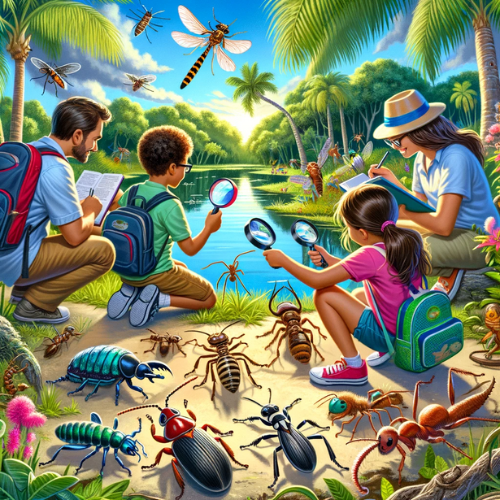
25 Jan Pest Identification for Kids
Pest ID for Kids!
Welcome to the exciting world of pest identification in South Florida! This region’s unique climate and diverse ecosystems make it a perfect home for a variety of interesting insects and critters.
Whether you’re a parent, teacher, or someone who works with kids, this guide will help you turn pest identification into a fun and educational experience for children. Let’s dive into the fascinating world of South Florida’s tiniest residents and learn how to identify them safely!
Pests are more than just uninvited guests in our homes; they play crucial roles in our ecosystem. Teaching kids about these roles helps them appreciate the world around them.
From pollinating plants to breaking down organic material, pests have jobs too. But, some can also be harmful. It’s important for kids to learn which ones are friends and which are foes.
A Learning Adventure
Identifying pests isn’t just educational; it’s a great way to connect with nature. By exploring their backyards or local parks, kids can discover a variety of insects and learn about their habits.
This hands-on approach to learning encourages curiosity and respect for the environment. Plus, it’s a perfect activity for children in South Florida, where the warm climate brings a plethora of bugs to study!
South Florida is home to an array of common pests. Let’s start with mosquitoes, known for their buzzing and bites. Did you know that only female mosquitoes bite? Or consider the termite, crucial for breaking down dead wood but a nightmare for homeowners.
Ants are another common sight, with their impressive colonies and teamwork. And let’s not forget about palmetto bugs, a type of large cockroach that often startles residents.
To help kids identify these pests, use visual aids like pictures or insect models. These can be found in books or online resources. Visual identification is key, especially when distinguishing between similar-looking species. Remember, the goal is to educate, not scare, so keep the tone light and fun.
Kid-Friendly Pest Discovery
Creating a pest identification kit is a fantastic way for kids to get started. Include a magnifying glass, a notebook for observations, and maybe even a bug-catching net. This hands-on approach not only makes learning fun but also encourages kids to explore their environment.
In today’s digital age, numerous apps and online resources can help kids identify and learn about pests. These tools often come with pictures and facts, making it easy for children to compare what they find with professional photos and descriptions.
Make learning about pests a game! ‘Pest Bingo’ is a great way to start. Create bingo cards with pictures of common pests and see who can spot them first. Or try a ‘Bug Scavenger Hunt,’ where kids search for different types of insects. These activities are not only fun but also educational.
Encourage kids to build simple insect traps or create a backyard bug habitat. These projects teach children about the living conditions and preferences of various pests. Group activities like these are perfect for classrooms or after-school programs, where children can learn together and share their findings.
Child Safety in Nature’s Tiny World
While exploring the world of pests, safety is paramount. Teach children to recognize potentially dangerous pests like venomous spiders or disease-carrying mosquitoes.
Educate them on the importance of not touching or handling unknown insects and the significance of telling an adult if they encounter something potentially harmful.
Kids should understand that while observing is okay, disturbing natural habitats isn’t. Encourage them to observe from a distance and respect the environment. This approach fosters a sense of responsibility and care for nature.
Your role as a parent or educator is crucial in guiding children through their pest identification journey. Offer support and supervision during their explorations. Help them use their tools and resources effectively and answer their questions with enthusiasm.
Green Pest Learning
For educators, incorporating pest education into your curriculum can be highly rewarding. It’s a subject that offers hands-on learning opportunities and aligns well with science standards. Parents can also integrate these lessons into everyday activities, like garden time or walks in the park.
In South Florida, it’s essential to balance pest control with environmental conservation. Teach children that not all pests need to be eliminated.
Some, like bees, are crucial for the environment. Highlight responsible pest control methods that don’t harm the ecosystem.
Through pest identification, children can become young environmental stewards. They learn the importance of each creature in their ecosystem and how they can help maintain a healthy balance. This knowledge empowers them to make a difference in their community.
Conclusion
In conclusion, our exploration of pest identification in South Florida has been both educational and engaging for children. This hands-on approach has not only taught them about the diverse insect world but also instilled a deep respect for the environment. Interactive tools and activities have made learning fun and meaningful, fostering a lifelong interest in nature.
Parents and educators play a vital role in guiding this journey of discovery. Their support and involvement are key to nurturing informed, environmentally conscious individuals. This foundational knowledge in pest identification paves the way for a generation that values and protects our natural world.


No Comments